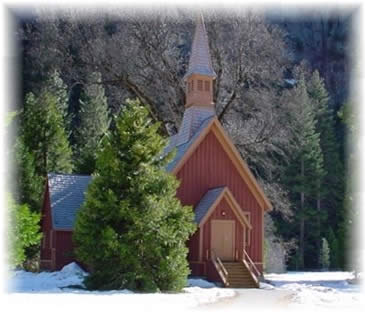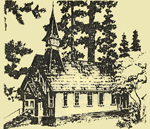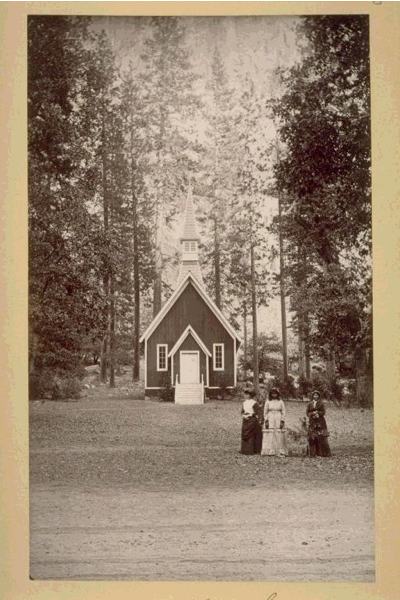Yosemite Valley Chapel
Our History

© Dan Warsinger Photography
The History of Yosemite Valley Chapel
Of the structures in public use in
Yosemite
National Park, the
Yosemite
Valley Chapel is now the oldest.
This little New England style church was built under the
sponsorship of the California State Sunday School Association,
partly by subscriptions from the children,
but mainly from the voluntary contributions of
prominent members of the Association.
The Chapel was built in 1879
under the auspices of the Yosemite Union Chapel Association.
Their stated purpose was:
"To erect an undenominational house of worship in the Yosemite Valley".
They took their inspiration from
two Old Testament
scripture verses:
Haggai 1:8:
"Go up to the mountain,
and bring wood,
and build the house;
and I will take pleasure in it,
and I will be glorified,
saith the LORD."
Isaiah 2:2:
"And it shall come to pass in the last days,
that the mountain of the LORD's house
shall be established in the top of the mountains,
and shall be exalted above the hills;
and all nations shall flow unto it."
Mr. Charles Geddes, a leading architect of San Francisco,
made and presented the plans.
Mr. E. Thomson, also of San Francisco, erected the building
at a cost of between three and four thousand dollars.
It will seat an audience of about two hundred and fifty.
Mr. H. D. Bacon of Oakland donated the bell.
When its first notes rang out on the evening of dedication,
it was the first sound of "the church-going bell" ever heard
in Yosemite.
["In
the Heart of the Sierras" by James M. Hutchings (1888)]
The first service was held on June 7, 1879, and the church
was filled to overflowing by delegates to the National Sunday
School Assembly who were meeting in Yosemite Valley at that time.
The first organ in the Chapel was given by Miss Mary Porter
of Philadelphia in memory of Florence Hutchings.
Florence was the unofficial, but faithful caretaker of the
Chapel during the summer of 1879-1881.
She died in a climbing accident at the tender age of 17.
In 1887, on the death of President Grant, a memorial service
was held in the Chapel.
The organist for the day was Sir Arthur Sullivan,
famed composer and collaborator with Sir William Gilbert
in the famous Gilbert and Sullivan light operas.
Sir Arthur was visiting in the Valley at the time and
was asked to assist in the service.
The original location of the Chapel structure was
on rising ground near the base of the Four Mile trail,
a mile or so down the Valley from its present site
on the south side of Yosemite Valley.
In the passage of years, the old Chapel, built in the midst of a
busy community, lost one by one its companion buildings, until,
with the moving on of community activity to other parts of the
Valley, it stood alone.
In 1901, it was taken down and moved to its present site.
The Yosemite Valley Chapel was given Historic American building
status by the
National Park Service
in 1965.
Following this, its interior was restored and
a new foundation was placed under it.
The Chapel became listed on the prestigious
National Register of Historic Places
in 1973 based on its "simple architecture" that was
representative of "a particularly fine example of the
early chapels constructed in the Sierra Nevada Mountains."
Although the Chapel continues today primarily as
a house of worship, over the years it has become
a popular
wedding
destination due to the spectacular setting
and the quaint beauty of the building.
The first Chapel wedding took place on October 24, 1884.

